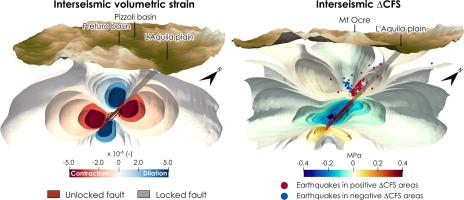当前位置:
X-MOL 学术
›
Tectonophysics
›
论文详情
Our official English website, www.x-mol.net, welcomes your feedback! (Note: you will need to create a separate account there.)
Three-dimensional numerical simulation of the interseismic and coseismic phases associated with the 6 April 2009, Mw 6.3 L'Aquila earthquake (Central Italy)
Tectonophysics ( IF 2.9 ) Pub Date : 2021-01-01 , DOI: 10.1016/j.tecto.2020.228685 Matteo Albano , Salvatore Barba , Christian Bignami , Eugenio Carminati , Carlo Doglioni , Marco Moro , Salvatore Stramondo , Michele Saroli
Tectonophysics ( IF 2.9 ) Pub Date : 2021-01-01 , DOI: 10.1016/j.tecto.2020.228685 Matteo Albano , Salvatore Barba , Christian Bignami , Eugenio Carminati , Carlo Doglioni , Marco Moro , Salvatore Stramondo , Michele Saroli

|
Abstract Although several observations have been reported in the literature before a strong earthquake, their relation with the forthcoming event is often controversial. Since many physical processes and parameters govern the dynamics of preparation, initiation, and occurrence of earthquakes, their understanding is essential for explaining anomalous seismological, geophysical, hydrological and geodetic signals before a strong earthquake that may be considered for seismic monitoring and hazard assessment. In this work, the interseismic and coseismic stress and strain fields associated with the 6 April 2009, Mw 6.3 L'Aquila earthquake are calculated via a 3D numerical model designed to simulate the crustal interseismic loading and the coseismic brittle episodic dislocation along the fault. The model adopts a framework of gravitational and tectonic forces that are compatible with the geodynamics of the Central Apennines region of the Italian territory. The model assumes a brittle upper crust, where the fault has stick-slip behaviour, and a plastic deeper crust, where the fault is in stationary creep. The results indicate that the concurrent action of gravitational and tectonic forces determines steep interseismic stress gradients at the transition between the creeping and locked fault planes that promote the coseismic subsidence of the hanging wall. The interseismic strain above the transition between that locked upper fault and its unlocked lower shear zone develops a dilated volume in the hanging wall and a contracted volume in the footwall. These stress and strain variations are compatible with seismological, geophysical and geodetic anomalies observed before the earthquake, i.e., Vp/Vs anomalies and location of foreshocks. Interseismic stress and strain patterns invert during the coseismic stage. The dilated volume, formed during the interseismic phase, will be contracted at the coseismic stage and, conversely, the footwall volume previously contracted will be expanded.
中文翻译:

与 2009 年 4 月 6 日 Mw 6.3 拉奎拉地震(意大利中部)相关的震间和同震阶段的三维数值模拟
摘要 虽然在强震前的文献中已经报道了一些观测结果,但它们与即将发生的事件的关系往往存在争议。由于许多物理过程和参数控制着地震的准备、引发和发生的动力学,因此对它们的理解对于解释强震前的异常地震、地球物理、水文和大地测量信号至关重要,这些信号可能被考虑用于地震监测和灾害评估。在这项工作中,与 2009 年 4 月 6 日 Mw 6.3 拉奎拉地震相关的震间和同震应力和应变场是通过 3D 数值模型计算的,该模型旨在模拟地壳地震间加载和沿断层的同震脆性偶发位错。该模型采用了与意大利领土中央亚平宁山脉地区的地球动力学兼容的重力和构造力框架。该模型假设一个脆性上地壳,其中断层具有粘滑行为,以及一个更深的塑性地壳,其中断层处于静止蠕变。结果表明,重力和构造力的同时作用决定了在蠕动和锁定断层面之间的过渡处陡峭的地震间应力梯度,促进了上墙的同震下沉。锁定的上断层与其未锁定的下剪切带之间的过渡上方的地震间应变在上盘中形成了膨胀的体积,在下盘中产生了收缩的体积。这些应力和应变变化与地震学、地震前观测到的地球物理和大地测量异常,即Vp/Vs 异常和前震位置。在同震阶段,震间应力和应变模式发生反转。在震间期形成的膨胀体积将在同震阶段收缩,相反,先前收缩的下盘体积将膨胀。
更新日期:2021-01-01
中文翻译:

与 2009 年 4 月 6 日 Mw 6.3 拉奎拉地震(意大利中部)相关的震间和同震阶段的三维数值模拟
摘要 虽然在强震前的文献中已经报道了一些观测结果,但它们与即将发生的事件的关系往往存在争议。由于许多物理过程和参数控制着地震的准备、引发和发生的动力学,因此对它们的理解对于解释强震前的异常地震、地球物理、水文和大地测量信号至关重要,这些信号可能被考虑用于地震监测和灾害评估。在这项工作中,与 2009 年 4 月 6 日 Mw 6.3 拉奎拉地震相关的震间和同震应力和应变场是通过 3D 数值模型计算的,该模型旨在模拟地壳地震间加载和沿断层的同震脆性偶发位错。该模型采用了与意大利领土中央亚平宁山脉地区的地球动力学兼容的重力和构造力框架。该模型假设一个脆性上地壳,其中断层具有粘滑行为,以及一个更深的塑性地壳,其中断层处于静止蠕变。结果表明,重力和构造力的同时作用决定了在蠕动和锁定断层面之间的过渡处陡峭的地震间应力梯度,促进了上墙的同震下沉。锁定的上断层与其未锁定的下剪切带之间的过渡上方的地震间应变在上盘中形成了膨胀的体积,在下盘中产生了收缩的体积。这些应力和应变变化与地震学、地震前观测到的地球物理和大地测量异常,即Vp/Vs 异常和前震位置。在同震阶段,震间应力和应变模式发生反转。在震间期形成的膨胀体积将在同震阶段收缩,相反,先前收缩的下盘体积将膨胀。

























 京公网安备 11010802027423号
京公网安备 11010802027423号